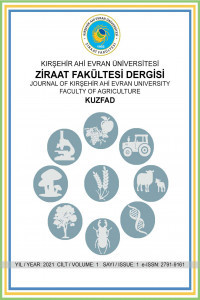Mus Linnaeus 1758 cinsinin (Mammalia: Rodentia) kürk morfolojisi özelliklerinin incelenmesi
Kemirgenlerle yapılan çalışmalarda ilk göze çarpan özellikleri dış morfolojik karakterleri yani kürkleri olduğundan kürk özelliklerinin tanımlanması oldukça önemlidir. Türkiye’nin batısında 40 lokaliteden toplam 562 Mus cinsi örneği kürk morfolojilerine bakılarak değerlendirilmiştir. İncelenen Mus domesticus örneklerinde postun dorsal kısmının koyu kahverengiden koyu griye kadar değiştiği, ventral kısmının ise açık kahverengiden koyu griye kadar değiştiği gözlenmiştir. Kürkün dorsal ve ventral kısmının birleşim yerlerinin belirgin bir hatla ayrılmadığı tespit edilmiştir. Kuyruğun tek renkli, kulakların ise sırt rengindeki kıllarla kaplı olduğu belirlenmiştir. İncelenen Mus macedonicus örneklerinde ise dorsal kürk renginin griden kahverengi tonlarına kadar çeşitlilik gösterdiği belirlenmiştir. Ventral kürk renginin beyazdan açık griye ve sarımsı tonlara kadar değişmekte olduğu, dorsal ve ventral kürk renginin ise birbirinden belirgin biçimde ayrıldığı tespit edilmiştir. Kuyruğa dorsalden bakıldığında koyu kahverengi, ventralden bakıldığında ise daha açık renkli olduğu görülmüş ve kulakların kıllarla örtülü olduğu gözlenmiştir.
Anahtar Kelimeler:
Ev faresi, sarı evfaresi, post özellikleri, Türkiye
Investigation of fur morphology characteristics of the genus Mus Linnaeus 1758 (Mammalia: Rodentia)
In studies with rodents, it is very important to define the fur characteristics, since the first striking features are their external morphological characters, that is their fur. A total of 562 Mus specimens from 40 localities in western Turkey were evaluated by looking at their fur morphology. It was observed that the dorsal part of the fur varies from dark brown to dark gray, while the ventral part varies from light brown to dark gray in the examined Mus domesticus specimens. It has been determined that the junctions of the dorsal and ventral parts of the fur are not separated by a clear line. It was determined that the tail was monochromatic and the ears were covered with dorsal colored hairs. In the examined Mus macedonicus specimens, it was determined that the dorsal fur color ranged from gray to brown tones. It has been determined that the ventral fur color varies from white to light gray and yellowish tones, and the dorsal and ventral fur color is clearly separated from each other. When viewed from the dorsal, the tail was dark brown, when viewed from the ventral, it was lighter in color according to dorsal fur and it was observed that the ears were covered with hairs.
Keywords:
House mouse, Macedonian mouse, pelage features, Turkey,
___
- Auffray J C and Britton-Davidian J (2012). The house mouse and its relatives: systematics and taxonomy. In: M Macholan, S J E Baird, P Munclinger, J Pialek (Eds.), Cambridge Series in Morphology and Molecules, Cambridge University Press, pp. 1-35
- Balčiauskienė L, Balčiauskas L, Vitkauskas V, Podėnas S (2015). Indoor small mammals in Lithuania: some morphometrical, body condition, and reproductive characteristics. Zoology and Ecology 25(4): 305–313
- Boursot P, Auffray J C, Britton-Davidian J, Bonhomme F (1993). The evolution of house mice. Annual Review of Ecology and Systematics 24: 119–152
- Csanady A and Mosansky L (2018). Skull morphometry and sexual size dimorphism in Mus musculus from Slovakia. North-Western Journal of Zoology 14(1): 102-106
- Cserkész T, Gubányi A, Farkas J (2008). Distinguishing Mus spicilegus from Mus musculus (Rodentia, Muridae) by using cranial measurements. Acta Zoologica Academiae Scientiarum Hungaricae 54(3): 305–318
- Ellerman J R and Morrison-Scott T C S (1951). Checklist of Palaearctic and Indian Mammals 1758 to 1946. British Museum (Natural History), London
- Kishimoto M, Kato M, Suzuki H (2021). Morphological and molecular recharacterization of the rodent genus Mus from Nepal based on museum specimens. Mammal Study 46: 297-308
- Krystufek B and Vohralik V (2009). Mammals of Turkey and Cyprus Rodentia II: Cricetinae, Muridae, Spalacidae, Calomyscidae, Capromyidae, Hystricidae, Castoridae. Knjiznica Annales Majora
- Macholan M (1996). Morphometric analysis of European house mice. Acta Theriologica 41: 255–275
- Marshall J T Jr (1998). Identification and scientific names of Eurasian house mice and their European allies, subgenus Mus (Rodentia: Muridae). Sprinfield, Virginia
- Orsini P, Bonhomme F, Britton-Davidian J (1983). Le complexe d’especes du genre Mus en Europe centrale et orientale: II. Criteres d’identification, repartition et caracteristiques ecologiques. Zeitschrift für Saugetierkunde, 48: 86-95
- Özkurt Ş Ö and Bulut Ş (2020). Türkiye Memelileri. Panama Yayıncılık, Ankara
- Schwarz E and Schwarz H (1943). The wild and commensal stocks of the house mouse Mus musculus Linneaeus. Journal of Mammalogy 24: 59-72
- Yavuz G (2022). Examination of some cranial characteristics of Mus domesticus Linnaeus 1758 and Mus macedonicus Petrov & Ruzic 1983 (Mammalia: Rodentia). Ahi Ziraat Der/J Ahi Agri 2(1): 43-55
- Başlangıç: 2021
- Yayıncı: Kırşehir Ahi Evran Üniversitesi
Sayıdaki Diğer Makaleler
Mus Linnaeus 1758 cinsinin (Mammalia: Rodentia) kürk morfolojisi özelliklerinin incelenmesi
Hatice ÖĞÜTCÜ, Yasemin ERBEY, Mahmut ERBEY
Yazgan TUNÇ, Kadir Uğurtan YILMAZ
Ticari probiyotik yoğurtların bazı mikrobiyolojik özelliklerinin belirlenmesi
Tarımsal İnsansız Hava Araçları ile Pestisit Uygulamaları
Bircan ALKAN, Gülden ÖZGÜNALTAY ERTUĞRUL
Hayvan beslemede alternatif fermente yem olarak: Chia (Salvia hispanica L.) bitkisi silajı
Gökhan FİLİK, Ayşe Gül CİVANER, Gizem KEZER
Kabaklı Göleti (Diyarbakır) Suyunun Su Kalitesi Özellikleri
